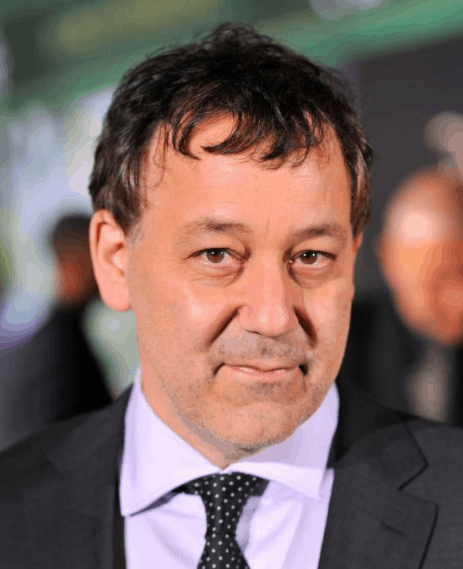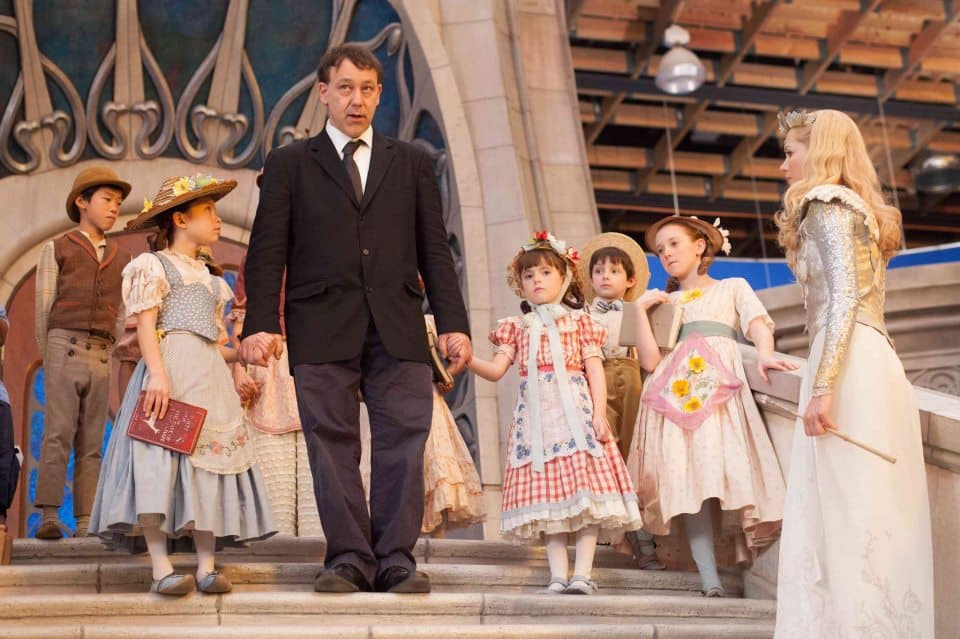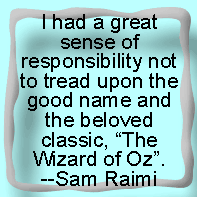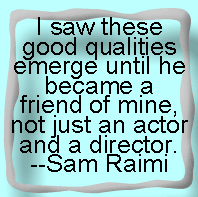
(Photo by Alberto E. Rodriguez/WireImage)
I am humbled to have had the opportunity to interview, Sam Raimi, the director of Oz The Great and Powerful! During the Disney Red Carpet Oz Event, I sat in front of Sam Raimi for a wonderful interview. His cast had nothing but nice things to say about him and how great he is as a director. He was very passionate about not losing the greatness of the original Wizard of Oz movie. He worked so hard at this film and it shows!
I found it very interesting when he talks about James Franco. At first, I was like, “I can’t believe he just said that!”! Then as I started to learn more. I think he looks at James Franco as almost a son figure. He worked with him in all of the Spider Man movies. He talks about some of the similar qualities that James has with the Wizard. He does focus on how James Franco has grown as a person. I found Sam to be EXTREMELY honest. At one point of the interview I ask him a question and he mentions his Mom. I quickly had to ask him if this was on or off the record. I didn’t want anything published that would get me in trouble. We had lots of laughs in the interview!
Check it out!

“OZ: THE GREAT AND POWERFUL”
Sam Raimi, center; Michelle Williams, right
©Disney Enterprises, Inc. All Rights Reserved.
Q : What’s it like having the weight of the Oz?
SR : I had a great sense of responsibility not to tread upon the good name and the beloved classic, “The Wizard of Oz”. That was my biggest fear. And it w– was that was a heavy responsibility. In fact I didn’t even wanna read the script. When I heard it was a prequel to “The Wizard of Oz”, I said, “I don’t wanna mess with that classic.” And so I didn’t read the script. And then a couple weeks later I was looking for a writer. And somebody said, “Read this. It’s a writing sample.”
 So under that auspices I read the script. And I thought, “I’m falling in love with this story and this world and these characters.” And so I thought, “That’s why I gotta make this movie ‘cause I feel uplifted by the end of this thing.” I love watching the main character learn how to become, you know, this selfish guy found a little bit of goodness in his heart and learned how to become this selfless individual. And that — and that could be really uplifting for the audience.
So under that auspices I read the script. And I thought, “I’m falling in love with this story and this world and these characters.” And so I thought, “That’s why I gotta make this movie ‘cause I feel uplifted by the end of this thing.” I love watching the main character learn how to become, you know, this selfish guy found a little bit of goodness in his heart and learned how to become this selfless individual. And that — and that could be really uplifting for the audience.
So it’s really those things that drove me to make it. And I thought, “If that’s really what I make the movie about, I won’t be treading on the good name of ‘The Wizard of Oz’ at all ‘cause it’s another positive story.” Yes?
Q : How did you make your judgment call on what was going to be too scary and how to reign back the scary so that that it still was a child’s or a family film.
SR : That’s something I was weighing all throughout the process. In the writing of the script if s– I’d made sure there was no violence in the thing ‘cause I really wanted to make it a family picture. And there really isn’t any violence in the thing. The worst it gets is…these real scary baboons came– come out of the mist where they go looking for our main characters so they hide in the cave…or there’s a scary witch at the very end. But I thought, “I changed the makeup once or twice to make it a little less scary.”
But then I thought, you know, when I think back on ‘The Wizard of Oz’…I’m from Detroit…so they used to show it like every Thanksgiving or every Christmas. I can’t remember which. I remember thinking, “This is the sweetest movie I’ve ever seen. But it’s also the scariest.” [LAUGHS] It was the scariest. So I wanted to make it — I tried to find a line like you’re saying where it’s scary for the kids, but not so scary the parents think, “This is — I shouldn’t have brought my child to see this.”
Just to the edge where the parents are about to take the kid away but the kid’s going, “No, let me stay.” [LAUGHTER] So I was trying to — to find that line actually. And I thought, “If there’s no violence and good wins out. And, um, then I think we should have a good scary witch and a good, uh, frightening moment with the baboon.” But I ho– I hope I found the line. I don’t know, did you think it went too far?
Q : I don’t think it went too far. I think maybe like seven or eight.
SR : Yes?
Q : As far as the role that James Franco played, did you always want him for Oz?
SR : No, I started — I wasn’t thinking about James. I think I had a long relationship with James and I really liked him very much. But I was thinking Johnny Depp would play the part or one or two other actors [He also mentions this on another interview on TV]. And it didn’t work out for them. And then I heard that James was interested. So I thought, “I never considered James. But he has the qualities,” as I sat myself down and thought about it, that I needed. And that was good and bad qualities.
This was the story of a real heel. A cad. A two-timer. He’s not a good friend. He’s a very selfish individual. Yet he wants to be great. He wants to be something more. He just doesn’t know how. He doesn’t know what true greatness is. And through the love of this little girl who looks at him like a father and through a flying monkey who like a good friend demands he do the right thing. And — and wanting to become worthy of Glinda’s love, he grows as an individual.
And finds a little bit of selflessness in himself. And in so doing becomes the great thing he always thought he could be. Never expecting that that was the route to become this great wizard. So James as a young man I had seen him be a little selfish. And a little into himself. And he had those failings. And then through the years as I worked with him I saw a generous spirit emerge working with the other actors.
 I saw kindness, a consciousness form ‘cause I knew him when he was like 21 all the way to I don’t know how old he is now. I saw these good qualities emerge until he became a friend of mine, not just an actor and a director. And I thought, “Because he’s — I’ve seen this in his real life, he’s a good enough actor. I think we can make this work on screen.” That’s really what it was. And that’s what casting’s about for me. Finding the essence of the character in a person.
I saw kindness, a consciousness form ‘cause I knew him when he was like 21 all the way to I don’t know how old he is now. I saw these good qualities emerge until he became a friend of mine, not just an actor and a director. And I thought, “Because he’s — I’ve seen this in his real life, he’s a good enough actor. I think we can make this work on screen.” That’s really what it was. And that’s what casting’s about for me. Finding the essence of the character in a person.
Sometimes a great actor comes in but they’re not the essence of the character. But James had all the qualities. And I’d seen a little bit of human growth within him in real life. So I thought he could portray this type of growth. The dramatic melodramatic growth, uh, on– onscreen in our picture. Yes.
Q : Which character would you say it your absolute favorite out of all of them? [This was me.]
SR : Well I — I — I admire Evanora. Rachel Weisz’s character because she’s so nasty. And she doesn’t try and hide it. I mean she, yes, she puts on [LAUGHTER] illusions but she really digs who she is. And that’s really [LAUGHS] it’s like wow! That’s like my mother, you know. [LAUGHTER] So [INTERVIEWER INTERRUPTS]
Q : On the record or off the record? [LAUGHTER] [This was ME again…I didn’t want any family fights.]
SR : No, it’s alright. My mother knows who she is. [LAUGHTER] But I admire that about that character. But I — I think I love, um, you know, James Franco’s character. There’s so much I can identify with the — I can identify personally. Unfortunately with a character that’s more in Kansas than — than the guy he becomes. But I understand wanting to become a better person. I mean it’s a dream. Whether I’d ever have the courage of that character to do what he did I don’t know. But I can relate to the character.
I understand his failings and his simple desires and his, um, his — his low qualities. Um, but I love the China Girl. She’s, um, for me my sweetheart. [LAUGHTER] Yes.
Q : Can you tell us about the selection process for the other characters and the actors that you chose [INAUDIBLE].
SR : Selection process for the actors?
Q : Yeah. And the other characters like Glinda and [INAUDIBLE].
SR : Well, um, basically the selection process was…I would meet different actors and they would come in and we would talk about the role. And I would kinda get — try and get a sense of who they were. It’s very difficult ‘cause they’re trying to impress you, you know, and trying to look pretty or handsome and be charming. I’m thinking, “Yeah, but I’m trying to see if you’ve got, you know, real goodness inside you. Can you play Glinda? Do you have a sincerity of your soul?”
And it — it’s hard in an interview situation because they’re pretending to be something, you know, and I don’t want that. I really want to know who they are. So as quickly as I can get past the niceties and really start talking to them, the better for me to really understand who they are. But basically, um, different actors I heard wanted to come in and read and audition for the role. And I’d meet and talk with them. And it went very much like any other process for the actors, for the technicians. We would discuss the work. And if we found that we were talking about the same thing and we’re really connecting.
And then — then usually we would bring them aboard for the project. Did I answer that question alright? [LAUGHTER] Yes?
Q : With the sets there was so much lushness and details. Did you go into it saying I want this set to be so real for the actors to experience and become that or what was your thought process on that?
SR : Well, um, once the look was decided by myself and the production designer of the entire production, then it came down to what are we gonna build and what would be just CGI? And yes, it was important for me to, um, have real places for the actors to touch and see so they could ground the movie. Because it’s such a fantastical adventure, I really needed to ground it more than a regular drama with real human performances. We had to explain the emotions that we understand and can connect to.
So having them grounded was important. And that’s why we did have sets. But we also had sets because I wanted a very unique look in Chinatown, a unique look in Emerald City. I wanted the Land of Oz to be this uniquely fantastical place. The dark forest to be a particular type of scary, et cetera. So many worlds within this fantastic world. So I found because so much of the world is created by CG artists, if I could photograph a particular rock.
James Franco on that yellow brick road. Dappled sunlight happening on that yellow brick road, the CG artists — CGI artists that had to continue that world had to do just that. Just continue this look we filmed on set. With the lighting, the exposure, the deta– detail. They don’t have to create it on their own because I thought I’d lose control of the look of the picture. So I wanted to really specifically always have some stylistic element on film that the artist’s job was to extend.
Which is still a great artistic job, but at least it’s of a kind of a unique look that’s carried on. Yes?
Q : How was it going back to your hometown and film?
SR : It was great going back because the movie — Disney was gonna go take it to Vancouver. And I love Canada, but I wanted the job to stay in either the United States or Michigan specifically where I’m from. It’s really depressed.
Disney let me bring the movie to Michigan. And we were able to keep the money in the states and employ a lot of Michiganders. And they were great actors. And they were really such a hard working crew. Everybody in Hollywood was super surprised how talented and how deep the t– the, um, technical skills were of the Michigan artists and technicians. And it was a real eye opener for a lot of, uh, lot of guys working on the movie how — how great those Michiganders were. And I loved going home.
Q : Would you go back and do another movie in Michigan?
SR : Yes.
Q : How different was it working on this movie as opposed to other movies that you have done before?
SR : Well the size of it was en– enormous. That took some getting used to. Because the Land of Oz is how Frank Baum wrote it, it was — it has such impassible deserts, fantastical waterfalls, outrageous mountains and woods. Um, we couldn’t really go and shoot Ireland and let it work for the green hills of Oz. Or we couldn’t shoot some great New Zealand mount scape ‘cause it just wasn’t outrageous and unique enough. So everything had to be created in the computer.
And working with the great production designer, Robert Stromberg, he did that by creating the smallest things first. The smallest blade of grass. What does it look like in Oz? What does the smallest blossom look like? And then multiplying by a thousand to see what a field might look like. And then working into building each individual tree to make it a unique thing. And everything — everything had to be created. There was not a pocket watch that should have been, you know, manufactured by some Swiss company.
No, no, it had to be an Oz watch. There’s not a vehicle. Every car — it had to be handcrafted. So the enormity of building a world was the most difficult job.
Q : I love how you paid your respects to the original movie and portions of that was very nice to see. At the end I would like one more. So are we gonna get a sequel?
SR : That’s very nice of you, thank you. And, um, [LAUGHTER] that would — I think that’s all up to the people of, uh, Disney Studios. Most probably the movie would have to make a lot of money for them. It would have to be critically acclaimed and au– the audience would have to want it. So that’s still way down the line. It’s all unknown right now, um, whether that would happen for the Disney people to make that decision.
***Be sure to remember that Oz The Great and Powerful will be playing in theaters on March 8th!***
Disclaimer: Disney paid all of my expenses to travel and have these unique experiences and interviews. All opinions are my own. Luckily, this was such an easy movie to LOVE!